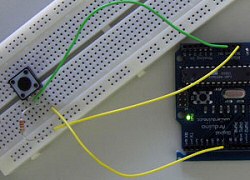You’ve heard about it – but what REALLY is an Arduino, and what do you use it for?
What an Arduino is depends on who’s asking:
- If you’re a hobbyist you might want to know how easy is it to use to do what you want.
- If you’re an artist, maybe you’re curious about making your latest art project ‘active’, and need to understand the Arduino because that’s a popular way to do it.
- And if you’re a current Arduino user, you question is more like ‘what isn’t an Arduino?’ since it is so versatile!
In an nutshell, an Arduino is like a computer you can hook electronics up to – and not just modules you buy completely made up and ready to go (which they have many of, called ); it’s also great for hooking up little electronics parts.
For instance, say I have a resistor and a switch (as shown on this page) – now I can hook up my Arduino like this:

And when I press the switch, the Arduino can notice it and do ‘something’ – and that something is limited only by my imagination (almost), along with enough parts, of course. For example, basic Arduinos come with a built in LED, so a program could very easily detect my switch, and flash the LED when I pressed it. But because that is done in programming code, I can easily change what that switch does with the LED. For instance,
- When I press the switch it turns on, and when I release it, it turns off. Pretty simple.
- How about one press turns it off, and another turns it on? Again, simple.
- How about the LED flashes slowly, and every time I press the button it flashes faster and faster? Now you’re on to something interesting.
- Or, what if you program a little ‘munchkin’ inside the Arduino, and now when you press the button, it reacts like you’re patting it – a quick press makes it flash ‘angry’ (fast but long bright flashes, for example), and when you press slowly it ‘soothes’ it (slower flashes). No real munchkin of course – just software programmed to react to how long you hold the button down.
So with only a few lines of code you have programmed the Arduino and a switch to look ‘alive’. Now you can see why it’s so popular with artists. Using motors and switches and a device like an Arduino, they can give ‘life’ to their art, having it interact with viewers. Here’s a video of an art project turning pieces of wood by motors to reflect different amounts of light – thereby acting as a ‘mirror’ showing a camera image:
Of course, this is a very popular use for Arduinos, controlling stepper motors (motors that can be very precisely turned under Arduino control). I’m using a similar thing for my Braille project, where two stepper motors are run this way for precise positioning.
But another very popular use for Arduinos is light control. Just as the example I gave here used a single LED to imitate life, a cluster of LEDs can be animated with the Arduino. For example, here is a project where an series of lights (LEDs) are used to create a truly beautiful dsplay:
Like the switch example, connecting an Arduino up to LEDs is less complex than using a whole computer for a project; yet, at , it is a computer that can do quite a bit despite its small size.
Finally, there is one more thing the Arduino is good for, at least in my case – and that’s a . All my life I’ve wanted to wire resistors and capacitors and all those other things together to do neat stuff. But, besides being expensive, all I could see in my future was burned resistors and acrid smoke! However, with the Arduino, there is a huge wealth of information online, and it’s very easy to wire a circuit up, test it, and gain experience in electronics. For hobbyists, it is truly a great tool to learn electronics with.
So I hope I’ve convinced you the Arduino is the way to go. If you’re a beginner, consider a kit with the Arduino Uno (the most popular version currently), and a generous supply of parts like switches, motors, resistors and such so you can play around with it. Check the listings below, and don’t forget to visit a forum or two, or search for specific projects using the Arduino. Who knows, you may find the beginning of a great new hobby!
